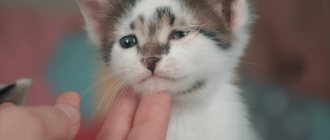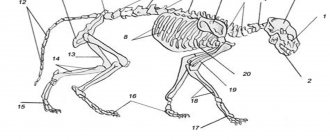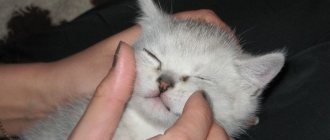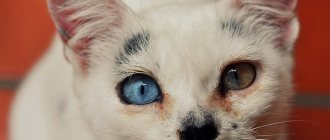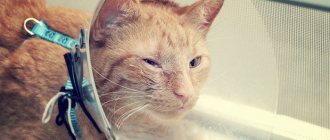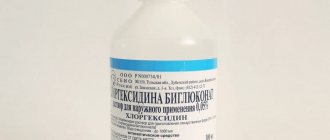15 days after birth, the eyelids should open. It happens that a kitten’s eyes do not open. In this case, you can try to rinse the visual organ by brewing black tea without sediment. If this does not help, you should show your pet to a veterinarian. Otherwise, there is a risk of developing ankyloblepharon, conjunctivitis, or possibly a genetic deviation - the kitten may have no eyes.
The main causes of red eyes in cats
In order to answer the question of what to do in case of hyperemia and swelling of the eyes in cats, it is necessary to reliably establish the cause of the problem. Redness of the eyes is a symptom of an inflammatory process, the causes of which can be varied. One of the most common causes may be a bruise or injury to the eyeball received while playing with sharp objects or with other pets. In such cases, open bleeding develops or inside the lens, which poses a serious danger to the preservation of vision. To avoid dangerous consequences, you should immediately seek veterinary help.
In some cases, a red eye may be the result of an allergic reaction. Allergens for the eyelids include household chemicals, house dust, food, and medications.
But the causes of red eyes can often indicate ophthalmic diseases:
- Glaucoma.
- Uveitis.
- Conjunctivitis.
- Blepharitis.
- Entropion.
- Keratitis.
- Corneal ulcer.
- Lens luxation.
- Proptosis and other eye diseases.
Glaucoma - with this disease there is swelling and redness of the eyeball, clouding of the cornea, dilation of the pupil and lack of reaction to bright light. Glaucoma occurs as a result of mechanical injuries and inflammatory diseases. It can also be congenital. Glaucoma is one of the most common eye diseases and is one of the factors leading to complete or partial loss of vision.
Uveitis is an ophthalmological disease represented by inflammation of various organ structures, most often the choroid of the eye is affected. With uveitis in a cat, you may notice severe lacrimation, severe photophobia, pain and anxiety when trying to look at a source of bright light.
Conjunctivitis is one of the most common diseases of the organs of vision, which is an inflammatory lesion of the conjunctiva of the eye. Most often it occurs in pets - Scottish dogs and cats. Conjunctivitis is a disease caused by infection, the presence of parasites, and dust and dirt getting into the mucous membrane of the eye.
Blepharitis is an inflammatory disease that is accompanied by redness and swelling of the eyelids. Develops against the background of a fungal or bacterial infection, allergy or other irritation. The presence of pathology can be determined by the following symptoms: the eyelids are swollen and inflamed, the cornea becomes cloudy, the cat or dog constantly scratches the eye. This indicates that the animal is experiencing severe itching and burning.
Entropion is a severe pathological condition that represents an inward turning of the lower eyelid. At the same time, the eyelashes begin to stick to the eyeball, causing a lot of unpleasant sensations in the cat. Most often, the disease is accompanied by sharp pain, hyperemia, lacrimation, blepharospasm - that is, uncontrolled blinking.
Reasons for not opening eyes
Cats fight: the main reasons for the behavior and what can be done to wean them off
The eyes of small kittens open gradually. First, a small crack appears, most often this can be observed from the inside. Then the iris becomes visible. They become cloudy within a week, so you should not expose babies to bright light. Most often, the cat itself brings the cubs out of hiding when the time is right.
Each kitten develops individually. Even within the same litter, some develop faster and more actively than others. There are often situations when the first kitten born begins to see before everyone else.
Late eye opening depends on several factors.
Breed
Each breed has characteristics at the genetic level. They consist in the fact that opening the eyes can take quite a long period of time. These breeds include:
- Siberian and British kittens. Their eyes open only on the 17th day after birth;
- Siamese, Abyssinian and Sphynx breeds are born with open eyelids, and already on the fourth day their vision is focused;
- Fold-eared Scots and Bengals begin to see clearly within a week after birth;
- Newborn ragdolls take the longest to open their eyes. This is due to the fact that their visual organs develop slowly. These pets begin to see only on the 21st day of life.
Beautiful kitty
Siberian kittens
For your information! Representatives of short-haired breeds develop faster than long-haired ones.
Accommodations
The conditions in which children are kept have a great influence on the process. Healthy kittens that receive the maximum amount of nutrients develop faster. Viruses and congenital pathologies slow down the process of formation of the visual organs.
Length of pregnancy in cats
The rate of vision development is affected by the gestation period. The longer a cat is pregnant, the faster the offspring opens their eyes. There are often situations when, during a long pregnancy, female kittens are born with their eyes open. In this case, you need to pay special attention to moisturizing the shell to avoid the development of diseases.
Diagnosis of diseases and their treatment
Symptoms and treatment of vision pathologies in cats depend on the causes of their development. Redness of the eye occurs in most eye diseases, so only a doctor can determine exactly what triggered the development of redness.
Both veterinary clinics and specialized ophthalmological centers for animals provide assistance with red eyes in pets. Before seeking veterinary help, it is advisable to study everything about the clinic - doctors, work schedule, services. You can also call a veterinarian at home, but in this case you need to visit a clinic to diagnose an ophthalmological disease.
The doctor will examine the animal, prescribe all the necessary tests, and, if necessary, diagnostic hardware methods. Treatment tactics depend on the diagnosis made by the veterinarian. In no case should you delay therapy, as many diseases progress rapidly and can lead to serious complications for the cat’s vision. Some pathologies can affect other organs of the animal, significantly worsening its well-being.
In the initial stages of the disease, the use of drops and ointments for the eyelids is considered effective. In the most severe cases, treatment is performed surgically.
Prevention
Regular eye care for a cat is the key to its health and excellent vision. Basic rules of prevention:
- You need to carefully ensure that when playing in the presence of another pet, the organ membranes are not damaged or injured.
- When bathing your pets, it is very important that soap or shampoo does not get into the eyes, as this can cause irritation.
- For hygiene procedures, it is recommended to use a gel or other drug that does not cause allergies.
- When tear fluid is released, it must be removed with sterile cotton swabs.
- It is very important to ensure that the fur does not get into the eyes under any circumstances; if necessary, it should be trimmed 1-2 times a month.
Redness and swelling are the first signs of inflammation. If the owner notices that the cat has begun to actively scratch the eye area, it is recommended to instill artificial tear preparations behind the eyelid 1-2 times a day. They effectively relieve dryness and irritation.
If such a medicine is not at hand, it can be replaced with regular olive oil. The use of the drug Ciprovet is also recommended - it is an effective antibacterial and anti-inflammatory agent that relieves pain and discomfort, destroys pathogenic bacteria and viruses.
If, after applying all preventive measures, swelling and redness of the cat's eyes can be seen, it is necessary to protect the animal from constantly scratching the diseased organ. To do this, your pet should wear a special protective collar, and then immediately seek help from a veterinarian.
The best prevention of ophthalmic diseases in cats is an extremely caring and attentive attitude to the health of your pet. When the first signs of the inflammatory process appear, you must seek veterinary help. Only in this case can the cat’s health and visual acuity be preserved.
Home » Cats » The cat has one eye that won’t open
>The cat's eye won't open
Diagnosis of the disease
If your pet constantly closes its eye, a veterinarian will find out the reasons. If alarming symptoms are detected, it is necessary to take the cat to the clinic.
Diagnostics includes procedures such as:
- visual acuity test;
- assessment of the general condition of the body;
- examination of the visual organs for damage;
- comparison of symmetrical features (size and shape of pupils, eyelids, eyeballs and slits);
- Ultrasound of the affected area;
- staining test;
- CT or MRI of the brain;
- X-ray of the skull.
Ophthalmological pathology may be a consequence of traumatic brain injury. Therefore, the examination must be comprehensive.
It is recommended to donate blood, urine and feces for analysis. Problems with the eyes can be caused by pathologies of internal organs or parasitic diseases.
Treatment of eyes in cats that do not open
Unfortunately, even if an animal such as a cat is completely domestic, it is not at all immune from various types of infections and diseases. Diseases can await a cat almost anywhere, regardless of whether it spends all its time at home or walks outside. Eye diseases are especially dangerous in representatives of the cat family.
Signs of eye disease in a cat
In principle, it is not difficult to determine that a cat is suffering from a certain ailment. It is much more difficult to understand its cause. The owner of the animal should be alerted to absolutely any deviations from the norm of the animal’s behavior. For example, if a cat has some kind of discharge from the eyes or clouding of the eye, and also if the cat’s eyes do not open, this indicates that it is susceptible to a disease from a fairly large list.
A particularly large list includes eye diseases that cause clouding of the cornea. In this case, we can talk about completely different reasons: starting from the presence of too much pressure in the eyes, and ending with real viral infections, which as a result can lead to death.
Accordingly, if your cat suddenly begins to show signs of illness, it is advisable to immediately contact a veterinarian. This applies not only to opacities, but also to the presence of various discharges from the eyes, which are purulent in nature.
How to treat a cat's eyes
In principle, the main method of treatment, in fact, as well as the reason why eye treatment in cats is required, can only be determined by a doctor. It is not advisable to self-medicate an animal without the support of a specialist, especially if the treatment does not involve qualified methods.
If we are talking about only a slight inflammation of the eyes, then most likely it will be possible to get by with a “small scare” when carrying out various eye rinsing procedures will be sufficient.
Washing the eyes will not require the use of any specific medications; sometimes veterinarians advise rinsing the cat’s eyes with a tea leaves solution. It will help soothe your eyes and draw out any infections.
However, in most cases, the use of antibiotics cannot be avoided, especially when it comes to various viral diseases.
Features of eye washing
The eye wash procedure does not require any specific knowledge. But in order not to harm the animal, it is recommended to follow certain rules. Before you start processing, you must wash your hands with soap or a disinfectant solution. Then you need to moisten the gauze in the solution and carefully apply it first to one eye, and then to the other.
Why does a kitten's whiskers break: the main reasons and what to do
It is best to secure the kitten by wrapping it in a blanket so that it does not resist and does not harm itself. It is recommended to choose the position of the animal lying on its back. All movements should be smooth from the inner corner of the eye to the outer.
Important! It is strictly forbidden to press hard on the eyes. It is not recommended to make sudden movements, so as not to frighten the kitten even more.
Washing procedure
If the medicine needs to be instilled, it is necessary to open the eyelids slightly, then the drops are squeezed into the center of the eyeball.
Why doesn't the cat open one eye?
Often, owners notice with caution that the cat does not open one eye. Why does this happen, and what to do in this situation? Most often, the causes of this phenomenon are completely natural and not dangerous, but in any case you must always be on alert and, if necessary, provide assistance to the injured animal.
The cat does not open one eye: reasons
If a cat does not open one eye, it is worth considering that this phenomenon may be completely harmless and temporary. For example, many cats wash their paws too intensely, often accidentally touching their eyes. After this, the animal may not open the damaged eye for some time or squint it. Usually everything returns to normal within a few hours or even earlier. Sometimes a cat's eye does not open after sleep. This occurs because the fluid in the eye dries out, causing the eyelids to stick together. And again, there is no need to panic: relatively quickly the outflow of eye fluid will normalize, and everything will return to normal.
An equally common case is when a foreign body, such as a speck or grain of sand, gets into the eye. In such situations, the animal becomes more restless, often shakes its head and blinks the injured eye, and tries to clear the eye with its paw. If these actions continue for a long time, and the cat cannot open his eyelids, it is necessary to take measures, which will be discussed in more detail a little later. Please immediately note that the apartment where the cat lives must always be clean and tidy to avoid accidental dust or dirt getting into the animal’s eyes. Also keep an eye on what your pet plays with, especially if he is still young.
The presence of a foreign body in a cat's eye for a long time, as well as severe contamination, can lead to the development of conjunctivitis and other inflammatory diseases. In this case, the affected eye practically does not open, and if the cat opens its eyelids, it becomes clear that the cornea is severely inflamed and burgundy-red. Increased tearing may occur. The last symptom is often associated with various allergic reactions - to dust, insects, plants, foods, etc. In such cases, it is very difficult to cope with the situation on your own, therefore, most likely, you will need the help of a veterinarian.
What to do if the cat does not open one eye
If you notice that the cat does not open its eyes, do not panic, but carefully observe the animal’s behavior. If it does not show much concern, and after a while it begins to gradually open the swollen eye, no action needs to be taken. If this does not happen, think about more serious reasons - what could have happened to the animal recently? If a speck is to blame, you can try to rinse the eye by dripping warm water or tea tincture into it from a pipette, first opening it slightly (the animal must be held firmly in your arms).
If you suspect that eye damage may be serious, or your cat may have a strong reaction to an unknown allergen, do not wait until the last minute, contact your veterinarian. Treatment of eye diseases is based on several stages, including special procedures on an outpatient basis, as well as at home - instillation of eye solutions. The prognosis in many cases is positive - most diseases are treatable. There may be exceptions if the victim is a kitten or a very old and weak animal (over 15 years old). In these cases, if there is any suspicion of damage to the organs of vision, you must immediately run to the doctor. Remember that your pet’s vision also depends on your actions.
Kitten eyes
Cat's eyes are a visual organ that allows cats to hunt small prey even in minimal lighting conditions. This unique “night vision device” developed in cats during the process of evolution over many thousands of years and was inherited by our domestic cat from its wild relatives. Oddly enough, kittens are born without the ability to see at all - with closed eyelids. They begin to open their eyes and normally navigate in space with the help of vision only by the 10th–14th day of life, but even at this age the visual organ is at the stage of formation. Poor nutrition, infections, allergic reactions, injuries and other environmental factors can have a detrimental and often irreversible effect on a kitten's eyes.
As a rule, a person does not have to worry about the diet of a baby up to a month old - his mother takes on this responsibility. But as soon as the kitten begins to feed on its own, increased attention must be paid to its feeding. This transition occurs between the ages of one and two months. To develop good vision, a kitten’s diet must be as balanced as possible and contain all macro- and microelements in sufficient quantities. The cat's visual system is particularly sensitive to deficiency of taurine, docosahexaenoic omega-3 fatty acid, and vitamin A. Among the foods that fully meet all standards and norms for feeding kittens, the most attractive product lines are Purina® PRO PLAN® Junior® and Purina® PRO PLAN ® Junior delicate®. It has been proven that daily use of these diets for feeding kittens promotes the healthy development of the entire nervous system and the visual apparatus, in particular.
As mentioned above, infections and injuries can also have a detrimental effect on the visual health of kittens. In most cases, both of these problems manifest themselves in the form of inflammation of the eyes: there is an increased flow of tears, the eyes turn red, “sour,” and even purulent discharge may be observed. Treatment in each specific case may vary greatly. You should not self-medicate. At the slightest sign of ill health of the kitten’s visual apparatus, you should contact a qualified veterinarian. Among the first aid products, it is worth noting special lotions with which you can always treat and rinse the affected eyes, ensure proper disinfection and relieve inflammation. If trouble takes you by surprise and it is not possible to purchase medicine, do not despair; you can always use chamomile decoction or even tea (under no circumstances hot!) as a lotion. Just rub your eyes with them 4-5 times a day until you show your pet to a veterinarian, but you should not delay a visit to the doctor.
If you suspect an allergic origin of the disease, it is recommended to minimize the baby’s contact with potential allergens: house dust, cigarette smoke, pollen, poplar fluff... In the absence of exposure to allergens, as well as with minimal hygienic support, the likelihood of remission (improved eye condition) increases. .
To prevent eye diseases in kittens, it is enough to observe hygiene measures and strictly follow the vaccination schedule. Also pay attention to the environment surrounding the kitten and, if possible, isolate it from contact with potentially traumatic objects. Kittens genetically prone to increased lacrimation need to wipe their eyes once a day with a clean cloth soaked in lukewarm water. This will relieve them from souring and dry crusts that may appear after sleep. Rubbing should be done carefully, without pressure, from the outer corner of the eye to the inner. Also, decoctions of medicinal herbs, such as chamomile, are well suited for this procedure, but it is best to buy a specialized daily care lotion at a pet store - a consultant and/or your veterinarian will help you in choosing.
If a cat squints one eye, this may be a sign of an ophthalmological pathology. The symptom indicates that the animal is experiencing pain or discomfort. Eye diseases are often accompanied by suppuration and increased lacrimation. Lack of timely diagnosis and therapy leads to dangerous complications.
It is important to establish a diagnosis and begin treatment as soon as possible.
The cat's eyes are watery - what to do?
If you notice that your cat, cat or kitten has a watery eye, the pet is squinting or trying to scratch it, do not delay a visit to the veterinarian. This may be a sign of a serious illness.
It is considered quite normal if a kitten’s eyes become a little watery after sleep, as well as if there is a small amount of colorless discharge. But if one eye is watering profusely, swollen, or does not open at all, the animal most likely needs help.
Why do my kitten's eyes become watery and inflamed?
There may be several reasons why your cat, cat or kitten is watery, swollen and does not open:
- Infection. Chlamydia, herpes or mycoplasmosis viruses can cause this problem. It should be remembered that such infections are also dangerous for the human body, therefore, the sooner you contact a specialist to begin treatment for your pet, the better.
- Physiological characteristics of the breed. Some cat breeds that have flat heads are more prone to watery eyes. They are more likely to damage their tear ducts, and hair that gets into the eyes can cause irritation and infection of the mucous membrane of the eyes. In Sphynxes and other “hairless” cat breeds, a common problem is entropion of the eyelid. As a result, the cornea may be damaged. Cats of these breeds need special attention.
- Allergy. Just like people, cats can have allergic reactions to various types of irritants: household chemicals, dust, pollen, etc. Before you worry about treating your cat if it has watery eyes, try to identify the irritating factor and eliminate it.
- Mechanical damage. Watery eyes can also be caused by mechanical trauma. The animal could injure the cornea while playing on plant thorns, or as a result of dust and small grains of sand getting into the eye.
What to do if your kitten’s eyes don’t open or are very watery
In any case, if you don’t know what to do if your cat or kitten’s eyes are very watery or won’t open, you should consult a veterinarian. He will be the one who will be able to prescribe effective treatment and best help your pet.
Before going to the clinic, you can alleviate the animal’s suffering by using eye drops, washing your pet’s eyes with furatsilin solution, tea or chamomile decoction and wiping them with a cotton swab or a clean dry cloth.
How to help kittens open their eyes
Why do cats' eyes glow in the dark: the main reasons
What to do if the kitten does not open its eyes? If the eyes of newborns do not open for more than 10 days, you need to carefully examine them. It is important to pay attention to traces of suppuration, mucus, and any discharge from under the eyelids. If at least one of these signs is present, you should definitely show the kittens to a veterinarian.
There are several ways you can help open your kittens' eyes.
Brewing tea
You need to brew strong black tea, cool it and strain. Using a cotton swab dipped in tea leaves, wash your eyes several times, repeating the procedure every evening.
Eye wash tea
Boric acid solution
To prepare, 2 teaspoons of boric acid are dissolved in a glass of warm water, the solution is used in the same way as tea leaves.
Baking soda solution
This recipe is suitable if your eyes are festering. Baking soda is diluted in the proportion of 0.5 teaspoon per glass of water. Use a cotton swab dipped in the solution to blot your eyes every evening.
Chamomile decoction
Chamomile decoction is used in the same way as tea.
It is strictly forbidden to self-administer medications, especially antibiotics. This can be harmful to the kittens' health.
Chamomile decoction - an old folk remedy
For your information! There are situations when animals have ankyloblepharon. This is a pathology that represents a partial fusion of the eyelids. In such a situation, only surgical intervention is required.
My cat's eye is watering, what should I do?
There are situations when both experienced owners and beginners wonder: the cat’s eye is watering, what should I do? The causes of this problem and methods of treatment can be very different. You can remove some of the factors that trigger lacrimation yourself. In other cases, the help of a veterinary ophthalmologist or epidemiologist (specialist in infectious diseases) will be required.
Why are tears needed and where do they come from?
Mammals' eyes were inherited from waterfowl ancestors and are designed in such a way that they can work if their surface is dry. There are no problems with this in the sea, but on land the lacrimal glands, which constantly produce liquid, are responsible for hydration.
A passage begins in the corner of the eye that leads into the nasal canal and tears flow down it. We can say that the cat's eye is constantly watering.
The system works much like a bathtub drain: if the plug is open and the water flow is not too empty, the bathtub appears empty, but water flows through it.
Causes of excessive tears
Tears outside the eye appear for two reasons: if tears are produced in excess or if the outflow is impaired.
Most often, a cat's eye waters because the nasolacrimal duct is blocked.
Causes of obstruction of the lacrimal duct:
Infectious and inflammatory processes in the mucous membranes of the eyes, eyelids and
nasopharynx. The inflamed mucous membrane swells, becomes thicker and mechanically blocks the exit from the eye. This can happen with conjunctivitis, blepharitis, and rhinitis, both infectious and non-infectious. Blockage of the nasolacrimal duct. Cats can get a variety of things into their noses, from dust to insects. They block the channel, as a result the cat’s eye waters - the “bathtub” overflows.
Curvature and narrowing of the nasolacrimal duct. This is usually a congenital phenomenon and often occurs in cats with a depressed muzzle profile (Persian, Himalayan). The canal can become bent even after injuries in the area of the nose and cheekbone, and then the cat’s eye constantly waters. Such changes are usually incurable
Excess tears appear if:
Something got into my eye.
The cat's eye is watering
In such cases, the body tries to wash away the foreign object, intensively producing tears. permanent injury to the eye due to improperly growing eyelashes. diseases of the lacrimal glands;
allergic reaction.
It happens that a cat's eye waters because there is a blockage of the canal and excessive tear production at the same time.
How to make a diagnosis? A veterinarian can most accurately determine the reason why a cat’s eye is watering, but the owner can also roughly understand where exactly the problem is.
Excessive tearing can be caused by:
- Congenital pathologies;
- Infectious diseases;
- Injuries and foreign objects in the eye;
- Diseases of the eyelids;
- Acute allergy attack.
The first step is to carefully examine the sick animal. If a cat has watery eyes, not one, but both, he is lethargic, eats poorly, and his nose is dry and hot, you can suspect some kind of infectious disease - from panleukopenia to chlamydia. Very strong lacrimation occurs with cat rhinotracheitis, so much so that it seems as if the eyes are leaking.
If the pet belongs to one of the exotic breeds (Himalayan, Persian, group of British breeds), the tears are transparent, the cat’s eye is constantly watering, it is possible that the reason is the congenital narrowness of the canal and this cannot be cured. Check with the breeder whether the kitten has had this before and whether its parents’ eyes are watery.
In case of allergies, tears appear suddenly and immediately in large quantities.
In addition to tears, an acute allergic attack is manifested by heavy breathing, swelling of the face and paws.
When a cat's eye is watering, you need to carefully examine it to see if there is something stuck in it.
It is not always possible to determine the cause of tears by examination. In severe cases, an in-depth examination with special equipment is required.
What to do if a cat has watery eyes?
First you need to check if anything is stuck inside. Wool, slivers and blades of grass can be seen without much effort just with your eyes. If you don't find anything, it's worth trying
examine the sore eye through a magnifying glass.
The eye may become watery because the wing of an insect or a small piece of film is stuck in it. They cannot be seen without special tools, but you can try to wash them like any other item.
Rinsing is best done with saline or ophthalmic rinsing solutions.
You should not wash your eyes with tea - it contains tanning substances that have an irritating effect on the mucous membrane. In mild cases that will go away on their own, tea is simply useless, and in severe cases it can cause complications.
How to properly wash out a watery eye
It is most convenient to carry out this procedure with an assistant who will hold the cat - two hands are usually not enough. The cat is wrapped in a towel or blanket so that it cannot escape or scratch, and the assistant sits it on its knees, with its back to itself.
Using two fingers, open the eye as much as possible, pour a warm sterile solution from a pipette into the upper outer corner, so that it flows down the mucous membrane to the inner corner.
Typically, debris that gets into the eye is washed off with 5-7 ml of liquid.
After washing, clean the inner corner of the eye with a corner of a sterile napkin soaked in saline solution.
They wash the eyes not only if they suspect a foreign object, but also when treating inflammation - this saves medications and speeds up recovery.
The cat's eye is watery due to breed characteristics
Constantly flowing tears stain the fur, irritate the skin of the eyelids and muzzle, and can cause eczema and ulcers. It will not be possible to remove tears if the pet has an obstruction or narrowing of the nasolacrimal duct from birth; it will not be possible to cure lacrimation either on your own or with the help of a veterinarian. In such cases, you can only try to reduce the harm from the problem.
To do this, the rusty strips of the tear ducts are blotted with a clean, dry cloth, and then an ointment is applied to protect the fur and skin. Breeders and veterinarians recommend using zinc ointment - it is inexpensive and effective.
There is no point in putting eye drops in such cases, as there is already an excess of tear fluid there.
When you can't do without a veterinarian
Experienced owners cope with simple cases of tearing
independently - by rinsing using veterinary eye drops. But there are serious symptoms that require immediate medical attention.
Signs of serious illnesses that cannot be cured on your own:
- The discharge from the eye is viscous, thick, opaque;
tears are colored in dark gray, green, bright yellow tones; lacrimation increases every day; - Tearing appeared suddenly, profusely, accompanied by wheezing and swelling on the face - this is how anaphylactic shock begins in cats, in which case the animal needs immediate veterinary help! In addition to copious tears, the cat has lost its appetite or has a fever, coughing, diarrhea or severe lethargy;
- Incorrectly growing eyelashes were found in the eye. They constantly injure the mucous membrane of the eye, it is very painful. Simply removing eyelashes will not solve the problem; they will grow back very quickly. Only surgery on the eyelid will help, which will correct its position so that the eyelashes do not touch the conjunctiva.
A timely visit to a doctor will save your cat’s life!
>The cat does not open one eye.
Measures to prevent eye diseases
It is easier to prevent an ophthalmic disease in an animal than to treat it. Prevention includes:
- regular vaccination;
- preventing pet hypothermia;
- examination of the animal’s visual organs after street walks;
- washing the mucous membrane and eyelids with saline solution if wounds are found on them;
- timely contact a veterinarian.
A cat squinting its eye is not necessarily due to illness. Sometimes this is a variant of the norm, for example, when the animal is sleepy or calm. It is necessary to seek veterinary help if this symptom persists for a long time and is accompanied by lacrimation, pus discharge and deterioration in the pet’s physical condition.
The cat doesn't open his eyes
The cat’s eyes won’t open and are watering, what should I do?
Anton Vladimirovich Artificial Intelligence. The reason for a cat's closed eye. Yulka Avdeenko Pupil, closed 5 years ago 5 days ago my cat started walking with one eye closed. There was not much discharge of pus. Drops were given to him for the purulence of his eyes. But the eye still hasn't gone away. I live in a provincial town, I took him to the local state veterinary clinic, and only a nurse was there. She said that the cat’s third eyelid had come out and that surgery was needed. I was scared and don’t know what to do anymore, because such an operation is not performed in our city. I also doubt that the cat was diagnosed correctly. The nurse didn't even pick him up! Because I'm panicking! Half of the cat’s eye is covered with a thin white-gray film.. Petrova Oracle 5 years ago What’s wrong with your cat is an inflammatory process and not necessarily in the eye. Examine the eye in good light; if there are no foreign objects behind the eyelid, then you need to start treatment; surgery is not a solution to the problem. An unsuccessful operation or a non-specialist who performs it can leave the cat without an eye. It is necessary to understand the cause of the disease and eliminate it. The first thing is to drive away the worms. Is everything correct with the cat’s nutrition and bowel function? If not, this could be the reason. Often such a picture with the eyelid is a hidden course of viral infections. It would be better for you to be prescribed treatment by a doctor who should examine the animal. My mother’s cat was prescribed treatment for 7 days, injected with anandin and gamavit, and dekta 2 eye drops. A neighbor simply treated her cat with sulfacyl narium drops in the eye for 2 weeks and everything went away, the eyelid gradually took its shape and was removed. Or look for treatment on the Internet yourself! LadyRainicorn Student 5 years ago I got an infection in my eye! Memememe Pro 5 years ago Infection or Parasites. The veterinary clinic will explain everything to you. Olga Enlightened 5 years ago, look visually at what your cat’s eyelid looks like - compare it with the information on these links - maybe you’ll find something useful, but in general - I agree with the users - you need to go to the vet if you haven’t found it, go again Comrade Nataorkha Oracle 5 years ago Well, yes, it looks like inflammation of the third eyelid. Alexander the Thinker 5 years ago. Ru About the company Advertising Vacancies. We are constantly adding new functionality to the main interface of the project. Unfortunately, older browsers are not able to work well with modern software products. For correct operation, use the latest versions of Chrome, Mozilla Firefox, Opera, Internet Explorer 9 browsers or install the Amigo browser.
Eye diseases in cats
Fashion house photo wallpaper catalog
Oil for adenoids in children
Third eyelid in a cat: causes and treatment
Women's World Chess Championship 2021 results
Is it possible to plant chrysanthemums next to roses?
Htc sense technical specifications
Credit cards in Moscow on the same day of application
Questions for a veterinary ophthalmologist
Oriental dances Red Army
Contour lines on a topographic map
Central Bank of Kazakhstan exchange rates
Why does the cat have one eye closed and watery?
How much protein is in caviar
European underwear sizes in Russian table
Raw canon format
The inner (third) eyelid is a special thin membrane that protects the mucous membrane of the cat’s eye from dust and various damage. It is a thin light film, on one side adjacent to the cornea of the eye, and on the other, to the inner surface of the upper and lower eyelids.
In a healthy animal, the third eyelid can only be seen when blinking, tilting the head, or when the eye is irritated. In this case, the eyelid extends and lubricates the surface of the cornea with tear fluid. But pathologies of the nictitating membrane often occur. These include prolapse, adenoma and third eyelid prolapse.
Eyelid loss
If the third eyelid does not fold, almost completely covers the eye, and causes discomfort in the cat, this is a pathology. The animal begins to hide from the light, rubs its eyes, blinks and squints. Upon examination, you may notice increased lacrimation, redness and pus. This is a signal to urgently contact a veterinarian and prescribe treatment.
It happens that the film appears only on one eye. This happens due to the entry of a foreign body. Constriction of the pupil and drooping of the upper eyelid are the cause of neurological pathology. The third eyelid in both eyes indicates a serious systemic disease.
Most often, the cause is eye damage and infection in the wound (for example, during a fight). An infected wound may develop a creeping corneal ulcer or keratitis. The surface of the eyes becomes cloudy, erosion, white or greenish discharge appears. This condition is extremely dangerous and can lead to the death of the animal.
Causes of inner eyelid loss include:
- viral diseases;
- conjunctivitis;
- contact with toxic substances or foreign objects in the eyes;
- severe weight loss;
- bacterial and infectious diseases;
- injuries and mechanical damage to the eyes;
- allergic reactions;
- nervous disorders;
- eversion of the cartilaginous base of the eyelids;
- parasitic infections (for example, worms);
- diseases of internal organs;
- severe intoxication of the body;
- weakening of the ligaments holding the third eyelid.
If your cat experiences eyelid prolapse, it should be examined by a veterinarian.
Treatment of third eyelid prolapse should only be carried out under the supervision of a veterinarian. First of all, it is necessary to determine the cause of the disease. To do this, the doctor may prescribe a general and biochemical blood test, ultrasound of the eyeball, X-ray examination of the skull, MRI and CT tests.
If the disease is caused by a bacterial or viral infection, treatment is carried out using conservative methods (gel or drops, antibiotics, antiviral drugs). Immunostimulating agents (Mexidol-vet, Hemobalance, etc.) are often prescribed. There are cases when surgical intervention is unavoidable.
Important. You cannot self-medicate, use drops and ointments without a doctor’s prescription, put your hands into the animal’s eyes and try to return the membrane to its place. Do not use drops or gels intended for human treatment.
Sometimes eyelid loss goes away without a trace within a day. But you shouldn’t ignore this, because a relapse is possible. Before contacting a veterinarian, you can begin treatment at home on your own. To do this, you need to include plant supplements containing calendula, ivy bud, cornflower and plantain in your cat’s diet.
Eyelid loss may go away on its own, but then a relapse may occur.
If your cat's eyes are watery and purulent, you can wash them with warm water, olive oil or boric acid.
Eye injuries
Most often, a cat does not open one eye when a grain of sand, speck or any other foreign body enters it. Movement of the eyelids and eyeball causes pain, so the animal prefers to keep the eye closed. A characteristic symptom of this phenomenon is profuse lacrimation from a closed eye. Over time, tears will wash away the debris from the eye, and the cat will no longer keep it closed. This usually happens after a few hours.
Another likely reason that a cat’s eyes won’t open is an injury while washing itself. If an animal vigorously rubs its muzzle with its paws, it may accidentally damage the mucous membrane of the eye, or get hair under the eyelid. This causes discomfort, so the cat keeps the eye closed until the mucous membrane is restored or tears wash out the hair.
Cats often come into conflict with their relatives. If a cat comes back from a walk dirty, wounded and does not open one eye, it means he has experienced a serious fight with a competitor for his territory. In this case, it is recommended to observe the behavior of the animal. If the cat feels well, despite the injuries, demonstrates a normal appetite and normal behavior, there is no cause for concern. After a short time, the mucous membrane will recover and the cat will open its eye again.
The alarm should be sounded if wounds are visible around the eye, and blood, mucus or pus oozes from under the closed eyelid. If you notice such symptoms, your cat should be taken to the veterinarian as soon as possible to avoid loss of vision. Sometimes conflicts with relatives lead to severe injuries, and bleeding from a closed eye may indicate severe damage.
If the cat's right eye does not open, it is recommended to wait several hours. In most cases, a cat will keep its eyelids closed due to a common household injury. If there is no foreign discharge, and only slight lacrimation is observed, there is no reason to panic. If a cat keeps its eye closed for more than a day, you should show the animal to a veterinarian. It may be necessary to remove the foreign body. To prevent infection of the damaged eye, the doctor will prescribe antibacterial drops, solution or special gel.
About the vision of cats
To clarify the problem and correctly assess the current circumstances, the owner must know about the structure of the kitten’s eye. In relation to the human organs of vision, the eye size of pets is much larger. The retinal area also contains nerve endings or rods. There are almost 7 times more rods than cones, which indicates that furry friends have much better vision than humans, so they see well in the dark.
© shutterstock
The round shape of the eyeball with the lens located at the center helps to expand the viewing angle. The eyes are protected from the effects of external factors, that is, foreign bodies entering the eyelids and mucous membranes. Moreover, cats have three eyelids, and this only enhances their protection.
Research has found that cats see the world in color, and not in black and white, as many people think. It’s not for nothing that the kitten likes to sit next to the screen when watching TV.
Kitten eye problems
Often, owners of small kittens are faced with the problem of sour eyes, especially if the animal was taken from the street. Discharge does not necessarily indicate conjunctivitis or other pathology. Often souring occurs due to the fact that the kitten simply does not know how to maintain personal hygiene. In this case, it is recommended to use special products designed to care for the eyes of cat babies. You need to wipe your eyes with this solution several times a day, and after a few days the problem will be completely solved.
Conjunctivitis in small kittens taken from the street can be a result of dust exposure, and also often develops against the background of infection with parasites. In this case, you can get rid of the problem of souring and inflammation of the mucous membrane only through complex treatment.
In rare cases, an animal's eye does not open due to abnormalities in the structure of the eyelid or injuries received in childhood. This may be due to a fall, impact or other reasons. Kittens face this problem, but not adult animals. For congenital eyelid anomalies, drug treatment is ineffective, but the doctor can perform surgery.

